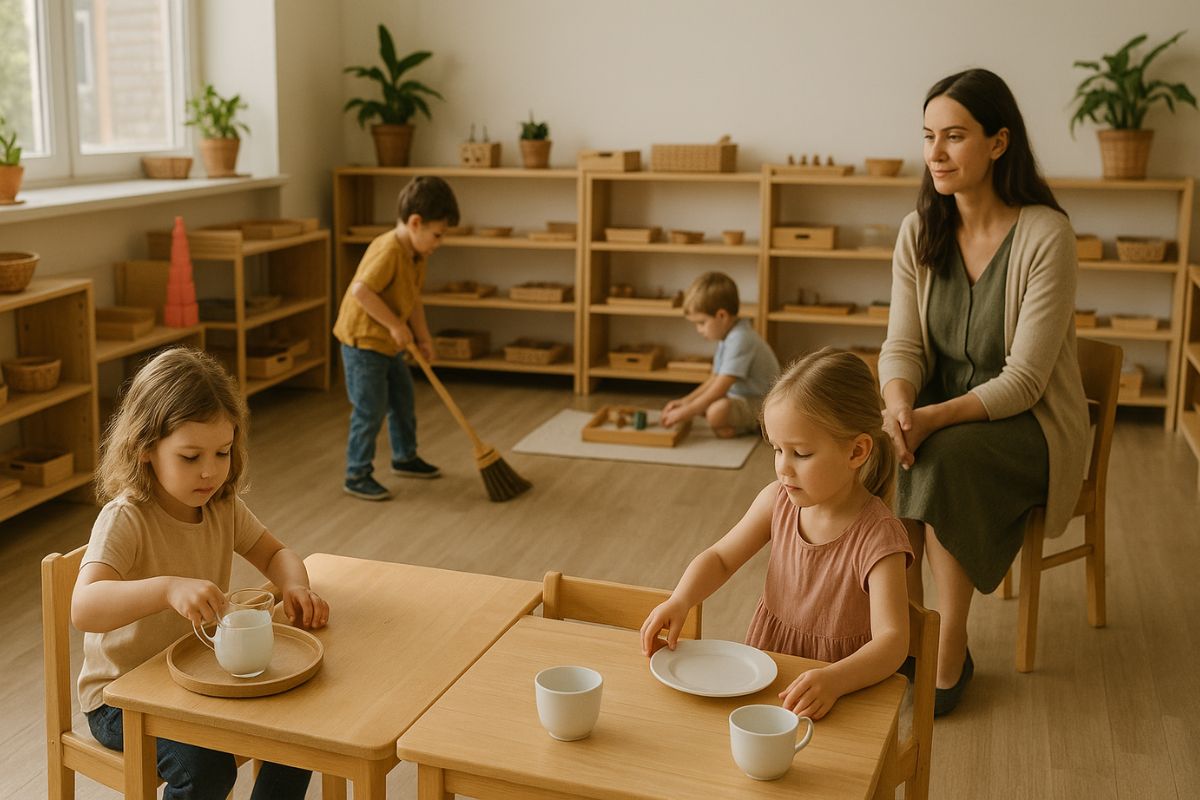Discipline is often misunderstood. Many think it means strict rules, punishments, or control. But in a Montessori setting, discipline looks very different. It’s not something imposed from the outside. It grows from within the child—developed through respect, choice, and self-awareness.
The Montessori approach believes that children are capable of self-control when they are guided gently and respectfully. Instead of focusing on correcting bad behavior through force or fear, this method supports children in understanding their actions and learning from them. The goal is not just obedience, but real inner discipline.
What This Article Covers
This post explains how discipline works in a Montessori environment and how it differs from traditional methods. You’ll learn about the role of freedom, the prepared environment, and the adult’s responsibility in guiding behavior.
We’ll also look at how Montessori helps children build self-regulation and respect for others—skills that go beyond the classroom and help shape thoughtful, confident individuals.
Discipline as a Natural Process
In Montessori classrooms, discipline is seen as a skill that develops with time and support. Just like walking or reading, it’s something children learn through experience, repetition, and gentle guidance.
Children are not expected to behave perfectly from the start. They’re given clear boundaries, choices, and natural consequences. Over time, they begin to understand how their actions affect others and how to manage themselves.
This approach removes shame from the learning process. Instead of being punished for mistakes, children are supported as they figure things out. That support helps them build true self-control rather than just avoiding trouble.
The Role of Freedom and Limits
Montessori classrooms offer freedom—but not without structure. Children can move, choose their work, and interact with others. But those freedoms are balanced with clear expectations.
This balance is where discipline begins. When children know what is expected and feel respected, they are more likely to act responsibly. They begin to understand that freedom comes with responsibility.
For example, a child may choose their activity, but they must use it respectfully and return it when finished. This kind of structure helps them internalize rules instead of relying on constant adult correction.
The Environment as a Guide
The physical space in a Montessori classroom plays a quiet but powerful role in discipline. Everything is designed to support independence, calm behavior, and purposeful activity.
Materials are within reach, arranged simply, and used in specific ways. The environment invites order and focus, which naturally reduces chaos. When children are engaged and know where everything belongs, they feel more in control—and behave accordingly.
A well-prepared environment gives cues that guide behavior. It encourages respect without needing constant reminders. It sets children up for success by removing obstacles and distractions.
The Adult’s Role in Modeling Discipline
Montessori teachers lead through example, not authority. They model calm, respectful behavior and speak to children in a clear and kind tone. They don’t raise their voices or use harsh punishments. Instead, they offer steady guidance and firm but fair boundaries.
When a child struggles, the adult doesn’t rush in to fix it. They pause, observe, and respond with intention. This might mean redirecting, asking a thoughtful question, or quietly sitting beside the child until they are ready.
This approach helps children feel seen and respected, even when they make mistakes. It builds trust and teaches children that guidance comes from care—not control.
Mistakes as Learning Opportunities
In Montessori classrooms, mistakes are expected and even welcomed. They are seen as part of the learning journey. Whether a child spills something, interrupts a friend, or chooses not to follow a rule, the response is thoughtful and non-shaming.
Children are encouraged to reflect on what happened and how they might do things differently next time. This reflection helps them grow and take ownership of their actions.
Instead of saying “You’re bad,” the focus shifts to “What happened?” or “How can we fix this?” That shift helps children feel safe enough to try again—and gradually develop real responsibility.
Inner Discipline vs. External Control
Many traditional discipline systems rely on external controls—punishments, rewards, or fear. Montessori seeks to build something deeper: inner discipline. That means the child begins to act with purpose and care because they want to—not because they’re being watched.
This type of discipline grows slowly. It comes from meaningful experiences, trust, and consistent guidance. It doesn’t rely on stickers or timeouts. It’s based on respect, choice, and connection.
When children feel valued and trusted, they are more likely to choose respectful behavior on their own. They want to be part of the community. They want to contribute in positive ways.
Supporting Discipline at Home
Parents can bring the Montessori approach into the home by creating calm spaces, offering choices, and setting clear limits with kindness. Instead of punishing, focus on understanding what your child is feeling and helping them find better ways to respond.
Use routines to create structure and consistency. Offer simple, age-appropriate choices—like choosing clothes or helping with chores. These small freedoms help children feel capable and respected.
When discipline issues come up, stay calm. Speak in a gentle tone. Ask questions that help your child think about their actions. Offer natural consequences rather than threats. Over time, these practices help your child build strong internal discipline.
A Foundation of Respect and Trust
The Montessori approach to discipline isn’t about control—it’s about connection. It recognizes that children want to do well when they feel supported and respected.
By focusing on trust, freedom within limits, and meaningful choices, this method helps children grow into responsible, caring individuals. Discipline becomes not just a set of rules but a path to self-awareness and respect for others.
This way of guiding behavior supports not only the classroom but the home, the community, and the future of every child.
